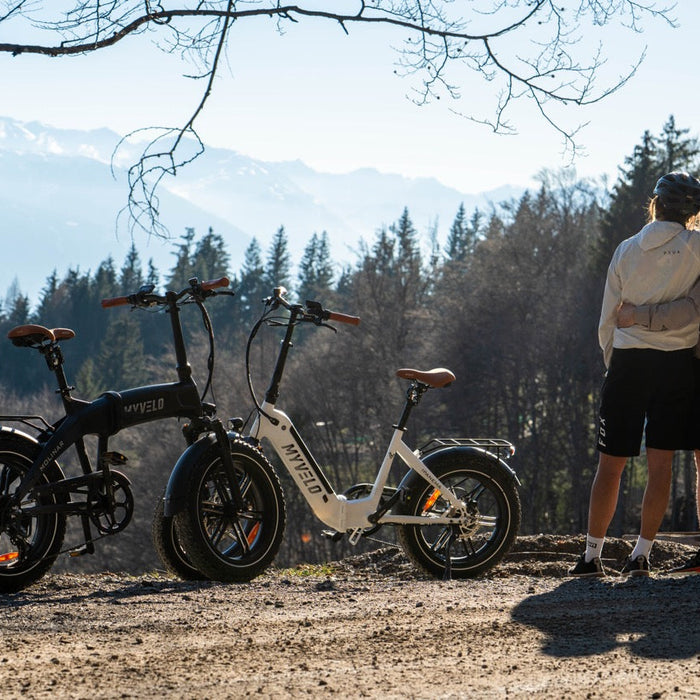

Too young for an e-bike?
Von Fabian Huber |
5 minutes read time

E-bikes have become increasingly popular over the past few years. The pedelecs, which are supported by an electric motor, do some of the work for you when cycling, so that you can get from A to B faster and don't break into an unnecessary sweat even on steep climbs.
With the e-bike you effectively increase the radius you cover with your bike.
For this reason, electric bikes are particularly popular among older people, who can use them to cover longer distances than they would be able to with a conventional bike. The same applies to commuters, for example, who extend their commute by using an e-bike. E-bikes are also popular for sports. E-MTBs, for example, make it possible to climb mountains that would otherwise be difficult or impossible to climb.
There are therefore numerous good reasons for younger riders to opt for e-bikes.
At what age are e-bikes useful for children and young people?
E-bikes are basically a sensible option for almost all cyclists. The main requirement is that the riders can handle the support speed of 25 km/h that is possible with Pedelecs that do not require registration. For this reason, e-bikes are often not a sensible option for small children, at least during their first riding training. Before your child dares to ride an e-bike, they should already be able to ride a conventional bike safely.
In general, however, e-bikes are also available for children aged six and over. However, these are limited to a maximum speed of 20 km/h and some models can even reduce the level of support even further. Opinions differ on the question of whether such an e-bike is the right choice for children for everyday use. E-bikes for children can definitely be useful when it comes to balancing out differences in performance. For example, on longer bike tours with the family, where the youngest riders are usually the ones who run out of breath first.
E-bikes for adults: At what age should you start?
The question of whether you prefer to ride an e-bike or a classic, non-electrically assisted bike depends less on your age than on your personal preferences and the distances you cover. Basically, if you only ride short distances without any significant inclines, an e-bike only really makes sense if you are a bit older. But who always rides the same short distances?
Sooner or later, you'll have to tackle a steep climb or go on a longer bike ride. Even if you regularly want to cycle a longer distance to work, an e-bike can be a sensible option. This applies regardless of whether you are 20, 40 or 60 years old. The electric motor helps you to cover distances that you would otherwise not cover by bike for one reason or another.
E-bikes in old age: These are the advantages of Pedelecs for seniors
For older people, e-bikes often mean a significant improvement in mobility and autonomy. In both rural areas and in the city, e-bikes enable people who can no longer easily cover long distances on a conventional bike to enjoy affordable and, above all, independent mobility in everyday life. Whether for visiting friends, weekend trips or going shopping, the bike with electric support is the ideal vehicle. At the same time, the increased mobility that comes with mobility also helps maintain physical fitness.
For older people who no longer feel safe enough on two wheels, electric trikes are now also available, which offer more stability. This means that trips into the forest and trips on uneven terrain are no longer a problem for older people.
More fitness thanks to e-bikes?
A common prejudice against Pedelecs is that riding them is less healthy than riding a conventional bike. In principle, it is of course also true that the power you don't have to exert on the e-bike means less muscle work and therefore less training. But that is only a small part of the truth.
In 2023, for example, the Hannover Medical School analyzed almost 60,000 rides with a view to their health effects as part of an extensive study with 1,250 e-bike riders and more than 600 "normal" cyclists. The result was astonishing: E-bike rides had almost as positive an effect on muscles and, above all, the cardiovascular system as rides on conventional bikes. The World Health Organization advises everyone to do at least 150 minutes of moderate physical activity per week . E-bike rides are a good way to meet this recommendation.
Since e-bikes are also used more regularly and for longer distances than other bicycles, this can ultimately have a more positive overall effect - assuming active usage behavior. E-bikes, for example, give commuters the opportunity to cover longer distances in a relaxed manner. Whether it's the entire journey to work or just the way to the nearest train station: an electrically assisted bicycle makes it more attractive to leave the car at home and cover the journey actively and on the move.
For a long time, it was assumed that the health benefits of e-cycling were offset by a higher risk of accidents. However, this has been refuted in accident research . E-bikes automatically mean that you cover longer distances. Older e-bike riders in particular often need some time to get used to the new possibilities. This is another reason why you should try out the possibilities of an e-bike as early as possible.
With the e-bike, family trips become much more relaxed
E-bikes are now available in a wide variety of versions. In addition to the ubiquitous e-bikes for adults, there are also pedelecs for children aged six and over. Unlike the large e-bikes, however, these children's bikes only support pedaling up to a speed of 20 km/h. But even at this lower speed, e-bikes for children are often the optimal solution for larger family bike trips. Anyone who has ever been on a bike tour with children knows that stamina is the biggest obstacle for children when it comes to tours lasting several hours. The same applies if grandma or grandpa want to come along on the tour or if you want to pull a trailer for the very youngest passengers. E-bikes help to level out differences in physical performance. So even if you don't feel ready for your first e-bike yourself due to sporting ambition, you can still benefit from the technology.
There are many good reasons not to wait until you are older to start riding an e-bike. Whether for the daily commute to work or weekend trips, e-bikes are now available in the widest possible variety. In our online shop for e-bikes, you can easily get a first impression and of course you can also order your e-bike directly. If you still have any questions, you can of course contact us by phone to help you with your purchase decision. Our advisory team is already looking forward to getting to know you.




